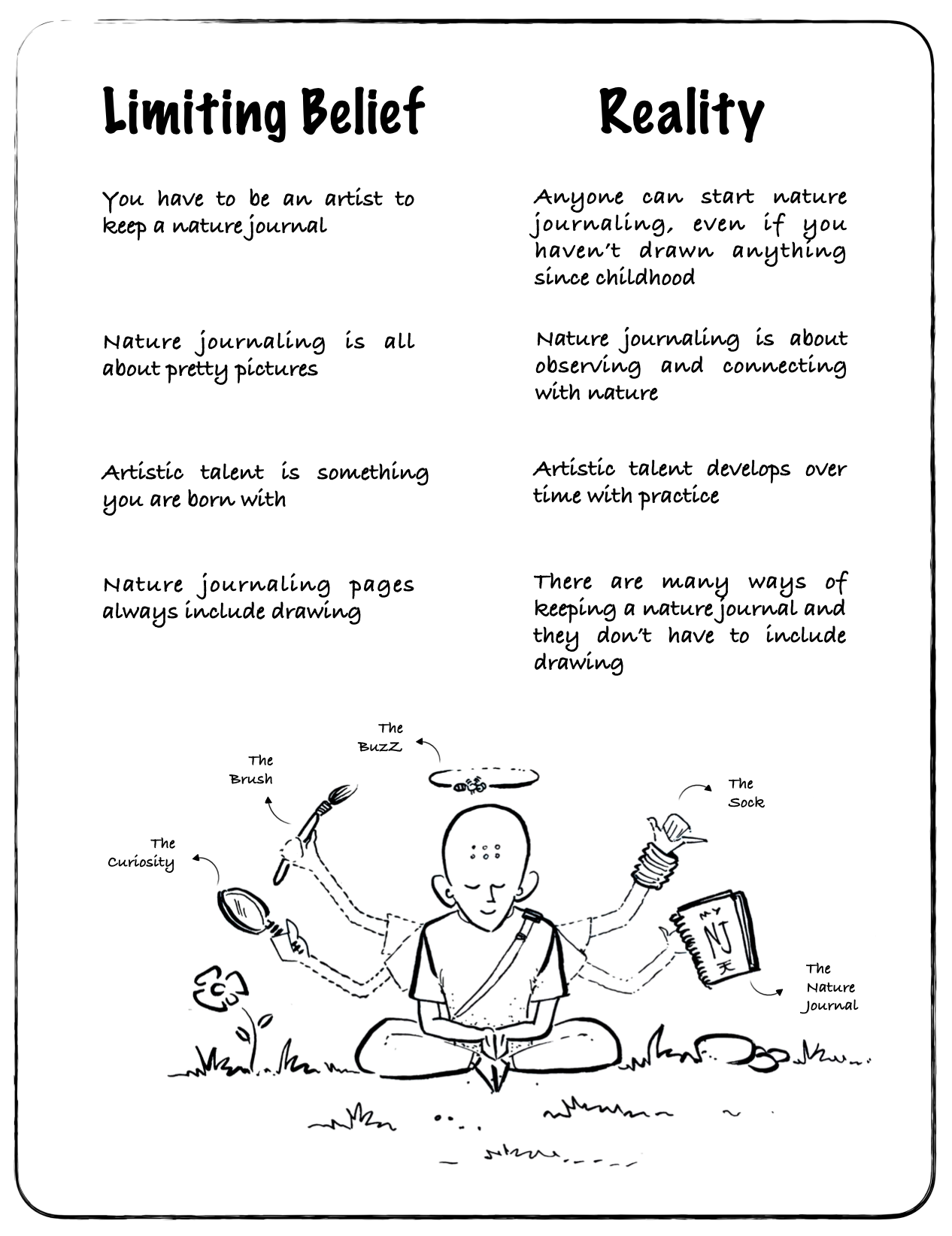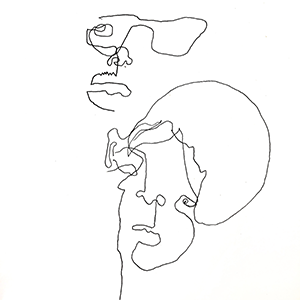For the reluctant artist
One thing that comes up very often when talking with new people about nature journaling is the perception that you have to be an artist in order to keep a journal. This is not at all the the case! This page is designed to ease those fears and help you get started.
Identifying limiting beliefs
Some limiting beliefs about nature journaling and art alongside the reality:
Illustration by Akshay Mahajan
Tips for improvement
The single most important thing you can do to become more comfortable and confident with sketching is to sketch! No matter what level of artistic ability you start with, the more you sketch the more you refine your skills. If you have been journaling for a while, look back over your own sketches and you will see how you have improved through repetition. If you are new to nature journaling, just make a start, get up some ‘pencil miles’ and you will watch your confidence and skill grow over time.
Have you heard of ‘sacrificial pancakes’? It’s a lighthearted way of saying that, just like when you cook pancakes and the first few are a little wonky and weird, the first sketches you do before you’re warmed up are always wonky and weird too, and that’s ok! These are the sacrificial pancakes and we need to understand that the sketches that come afterwards are built on these first few. You can’t have one without the other. Here is a video of John Muir Laws chatting about sacrificial pancakes. It will make you smile:
Field sketching vs studio painting
It is important to remember the difference between a journal page done in the field and one created in the studio. Do not compare your field sketches with someone else’s studio sketch or you are likely to feel despondent. Many of the nature journals you see on social media are done in the studio, the artist spending hours, or even days, crafting the perfect page. These should not be compared with a journal page done in the field. Both are entirely valid ways of keeping a nature journal, but comparing the results will lead to disappointment.
In fact, try not to compare your sketches with those of other people at all! The only useful comparison is with your own earlier work. You WILL notice improvements. Keep sketching!
Change your mindset
There are several exercises you can do to help relax and let go of drawing fears. In this blog post ‘Let’s NOT make art!’, Bethan Burton (Journaling With Nature) describes the process of using blind contour and modified contour drawing to have fun with sketching and let go of fears.
Jules Woolford (Drawn Into Nature) shares her personal story of feeling like she was a creative failure for many years, before slowly, bit-by-bit, coming to understand that creativity is something everyone can access: ‘A nature journal story’.
Akshay Mahajan has written a blog post entitled ‘A journal without fear’. This insightful piece recognises that when a mind is hardwired for perfectionism it will use all available means to create something perfect. What happens then, if you intentionally restrict your focus or your tools as a way of by-passing this perfection trap and allowing for ‘happy accidents’? Find out here.
John Muir Laws (johnmuirlaws.com) talks about the limiting effects of perfectionism in this article ‘The enemy of the good: moving beyond perfectionism’. He encourages you to think of your journal as a tool, not a precious object. This article will help you let go of your sketching fears!
In this blog post entitled ‘Small steps to sketching’, Jules Woolford (Drawn Into Nature) walks us through how to approach drawing in a calm way, taking small steps and making the process enjoyable and relaxing.
Environmental educator, artist and explorer Kim McNett explains in this video that if you can hold a pencil, you can draw and if you can see, you can draw from real life. Follow along with these easy exercises to start seeing the world as an artist!
Marley Peifer produces The Nature Journal Show on YouTube with weekly videos on all aspects of nature journaling. This comprehensive class on mindset will ‘Unlock your Potential’.
Another video from Marley Peifer and The Nature Journal Show entitled ‘How to nature journal even if you “can’t draw”’. This one is for those who have fears about sketching.
Books
‘Art and Fear’ by David Bayles and Ted Orland is a book that articulates the feelings that many people feel when approaching creativity. Fear, stagnation, self-criticism and feeling “stuck” are all part of the creative process. We can choose to move through these feelings and keep going, this book will give you ideas for doing this. One big takeaway: ‘For the artist, making good art depends on making lots of art.’
Artist and author, Danny Gregory, has made it his life’s work to teach people how to let go of fears and just make art! He has written many books and all of them are helpful for motivation and inspiration. Here are a couple that might be helpful for silencing fears about art:
‘Shut Your Monkey’ is a book about that horribly mean voice we all have in our heads, the one that says we are no good, the one that instills doubt and fear. Danny Gregory calls this voice the “monkey”. Others call it the “inner critic”. After battling it out with his own monkey, he knows how to shut yours down. Gregory provides insight into the inner workings of your inner critic and teaches you how to put it in its place. Soon you'll be able to silence that voice and do what you want to do--create.
Danny Gregory’s latest book ‘How to Draw Without Talent’ is for those who think they can’t draw. This book shows you how to get started making art for pleasure with fun, easy lessons. Get started fast with just a pen and paper, learn to see your subject with new eyes, and enjoy the creative process.
Cathy Johnson’s book ‘Artist’s Journal Workshop: Creating your life in words and pictures’ is full of ideas, exercises and inspiration for helping you let go of fears and just play! Creativity should be fun, and this book will help you find the freedom to experiment and find joy in the creative process.











